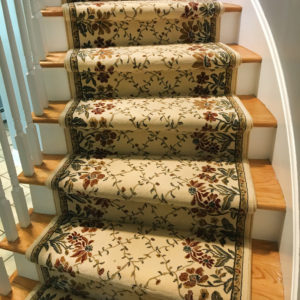
Stair runners play multiple roles in a home, including noise absorption, adding an accent through color or pattern and protecting the flooring material below. If you’re searching for a stair runner, consider the following factors.
What Is a Stair Runner?
A stair runner is a sheet of broadloom carpet, or a woven rug that is to be installed over a set of stairs. The material doesn’t cover the full width, leaving exposed wood or tile along the edges. The material may come in a pre-set size, requiring you to measure beforehand or can be customized to fit your home.
Why Add a Stair Runner?
Stair runners offer the following benefits:
- Safety: Wood and tiled stairs may be beautiful to look at but they also create a slip hazard for children, pets and adults with mobility issues. Along with a railing, stair runners add more traction for those climbing between floors.
- Dampening Effect: If you’re looking to reduce noise in your home, stair runners help diminish the sound of footsteps.
- Warmth and Style: By default, carpet adds more warmth to a space. A bold color or pattern from a stair runner serves as a stylistic accent that can be seen from certain angles. In the process, the material contrasts against any wood or tile present.
How to Select a Stair Runner
Type of Carpet
The stairs in a home see a fair amount of foot traffic. As a result, the material selected should be able to handle this degree of use, as well as dirt and debris. Short-pile materials are ideal, as they are less likely to show wear and appear crushed or flattened over time.
Additionally, consider a natural fiber like wool, as this material is resilient and offers greater durability. Synthetic materials are also available for staircases and offer a degree of durability as well as stain resistance.
- Wool offers the greatest resistance against foot traffic, needs to be vacuumed less than other materials and is less likely to show stains and dirt.
- Avoid shag carpeting, viscose, chenille and poor quality synthetic rugs, as they all show wear and shed relatively soon and can appear compressed over time.
Width
In addition to measuring the size of your staircase, get dimensions for the width. Ideally, any stair runner should leave three to four inches of wood or tile on each side.
Location
Where will you be installing the stair runner? Stairs leading to the outdoors should have better weather- and moisture-resistant runners. These locations will also see more dirt and debris from people and pets.
Along with being prepared to vacuum and deep-clean more often, look for materials that better resist dirt and stains to maintain the area’s appearance.
Colors and Patterns
When it comes to colors and patterns, there are a few questions to consider:
- Will you be treating the stair runner as décor? Feel free to experiment with colors and patterns. Linear, geometric and floral patterns all deliver a pop of color and more personality to your space.
- Are you looking for something practical? Focus your search on broadloom materials in neutral shades or patterns that easily conceal dirt and stains.
We offer exceptional custom installation for all stair runners. Visit our Guilford or Orange showroom to browse our inventory today!


